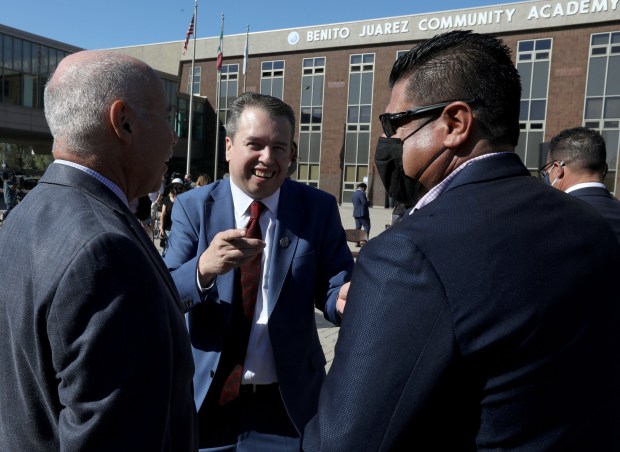Like any young Chicago Bears fan of the 1970s and early 1980s, my favorite player was Walter Payton.
How could it be otherwise? Sweetness was one of the all-time geniuses of the NFL, for years pretty much the only one worth watching, as the team slogged its way to mediocrity week after week.
My second favorite player? Quarterback Vince Evans.
Coming out of USC, as a sixth-round pick in 1977, Evans had a cannon for an arm, was probably the team’s second-best rusher behind Payton, and yet was routinely mired on the bench behind the noodle-armed Bob Avellini and Mike Phipps, who was about as mobile as Michelangelo’s David.
Because I was a kid, I was not aware of the ingrained systemic biases against Black quarterbacks that were at work, playing a significant role in creating a barrier between Evans and that starting job.
It wasn’t until Sept. 30, 1979, that two Black quarterbacks started for their teams when Evans and the Bears faced off against Doug Williams and Washington.
Evans and Williams are the central figures of historian Louis Moore’s fascinating exploration, “The Great Black Hope: Doug Williams, Vince Evans, and the Making of the Black Quarterback.”
Younger people who see all-pro quarterbacks like Patrick Mahomes, Lamar Jackson and C.J. Stroud, or the Bears’ hopefully future all-pro Caleb Williams may find it mind-boggling that a quarterback who could run and improvise on the fly, while also being able to throw the ball 80 yards in the air were looked at skeptically, but that was the pre-1990’s NFL.
Moore opens the book with brief capsules on great Black quarterbacks of earlier eras like Willie Thrower and Charlie “Choo Choo” Brackins who were given at best, begrudging opportunities under center, and at the first sign of trouble were on the hook.
In the ’60s and ’70s, great Black college quarterbacks were routinely made to switch positions in the pros to receiver or defensive back. Ingrained racist attitudes kept quarterback the province of white kids. The Black athletes were welcome only elsewhere on the field.
The bulk of the book tells the stories of Williams and Evans and how the idea of a Black quarterback had to take shape over time, becoming something of a group effort at overcoming prejudice.
In Evans’ case, it took two legendary USC coaches to reach his dream of the NFL. The first was John McKay, who Moore calls the “Branch Rickey” of college football, likening McKay to the Brooklyn Dodgers executive who paved the way for Jackie Robinson to break the MLB color barrier. McKay did not care about the color of a player’s skin if they could play and recruited Evans to succeed Pat Haden as the USC signal caller.
But after a disastrous first year under center, it took McKay’s replacement, John Robinson to see how to best utilize Evans, to let him move and throw, showcasing his speed and strong arm.
Williams was the product of a long effort by Grambling Coach Eddie Robinson to place Black quarterbacks in the NFL, an effort fully realized when Williams won the MVP of Super Bowl XXII.
Looked at through the lens of today, the prejudice and short-sightedness of these football men, including Evans’ Bears coaches, seems beyond idiotic. But as Moore shows us, this is no ancient history, and by no means has the full legacy of this prejudice been banished from sport.
Moore expertly brings both the individuals and the history they lived through to life on the page. Highly recommended for any football fan, especially those of us who continue to live and die for the Chicago Bears.
John Warner is the author of “Why They Can’t Write: Killing the Five-Paragraph Essay and Other Necessities.”
Book recommendations from the Biblioracle
John Warner tells you what to read based on the last five books you’ve read.
1. “Illinois in the War of 1812” by Gillum Ferguson
2. “Life, Liberty, and the Pursuit of Happiness: Britain and the American Dream” by Peter Moore
3. “Lost Enlightenment: Central Asia’s Golden Age from the Arab Conquest to Tamerlane” by S. Frederick Starr
4. “Missing Person” by Patrick Modiano
5. “A Dictator Calls” by Ismail Kadare
— David H., Peoria
A sort of sprawling list, which makes it tough to zero in on a specific target, but also gives me a lot of different targets on which to take aim: “How to Get Filthy Rich in Rising Asia” by Mohsin Hamid.
1. “An American Marriage” by Tayari Jones
2. “The Heaven and Earth Grocery Store” by James McBride
3. “A Well-Trained Wife: My Escape from Christian Patriarchy” by Tia Levings
4. “The Romanov Brides” by Clare McHugh
5. “The Bluest Eye” by Toni Morrison
— Julie J., Joliet
I think Julie is a good candidate for the family drama/ghost story of Angela Flournoy’s “The Turner House.”
1. “The Confidence-Man: His Masquerade” by Herman Melville
2. “An Artist of The Floating World” by Kazuo Ishiguro
3. “The Masterpiece” by Émile Zola
4. “Austerlitz” by W.G. Sebald
5. “Christendom: The Triumph of a Religion AD 300-1300” by Peter Heather
— Jim K., Chicago
I just received a bulletin touting the 20th anniversary of this book, which seems nuts to me because it feels like I just read it. I think it’s a perfect match for Jim’s interest in the world historical: “Cloud Atlas” by David Mitchell.
Get a reading from the Biblioracle
Send a list of the last five books you’ve read and your hometown to biblioracle@gmail.com.




